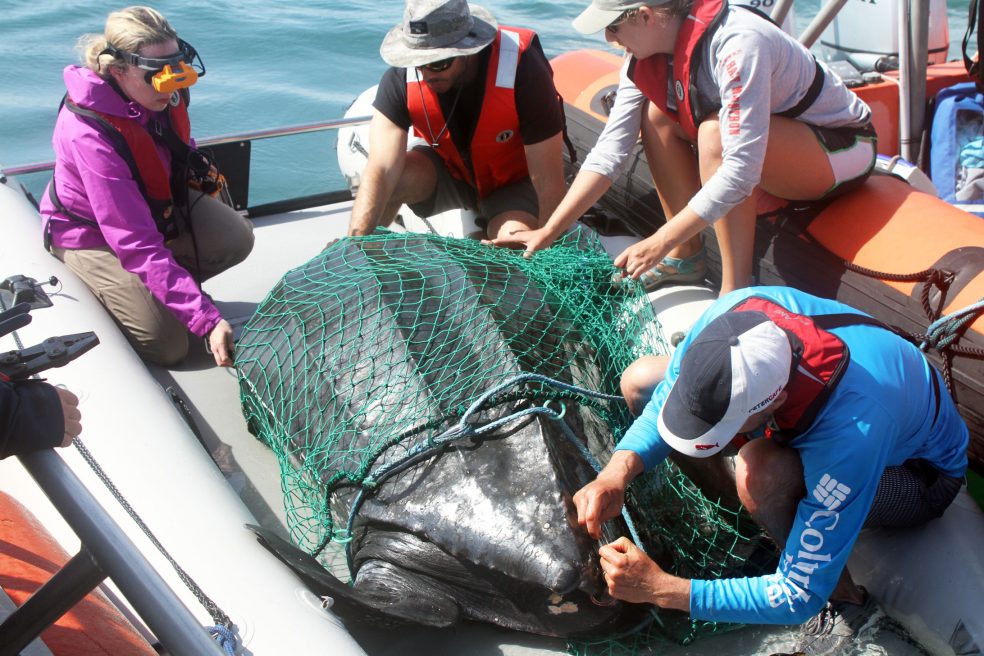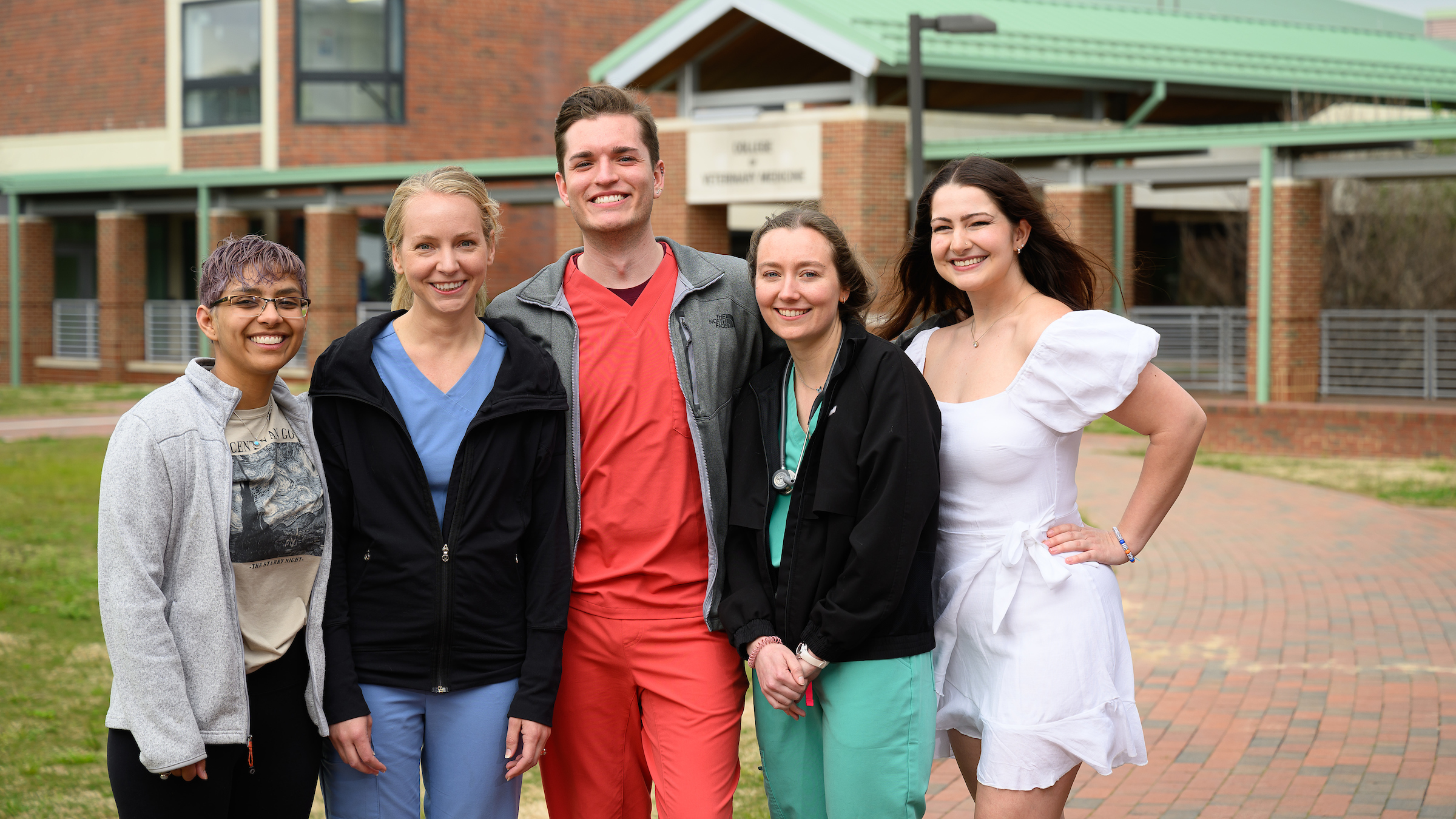Small Tags, Big Help for Endangered Leatherback Turtles

Craig Harms has spent decades working with marine animals, especially sea turtles, but a recent field project was an entirely different type of experience for the NC State College of Veterinary Medicine professor of aquatics, wildlife and zoo medicine.
In May, Harms was part of a large research team that recently tagged leatherback turtles off the North Carolina coast for the first time.
Harms and numerous collaborators in Beaufort worked from small inflatable boats to capture massive leatherback turtles. While the turtles were on board, researchers collected blood samples, took ultrasounds and studied heart activity before affixing satellite tags on each turtle to track their migration habits, especially in wind development and fishing areas off the Northeast U.S.
All of that took about 20 minutes per turtle.

Through the satellite tags, researchers hope to glean vital information about eating habits and the many threats to endangered leatherbacks, which can weigh up to 2,200 pounds and measure 8 feet long. Harms said the leatherbacks that migrate off the North Carolina coast may nest as far south as the Caribbean and northern South America and forage as far north at Atlantic Canada.
“The project is global health in our backyard,” said Harms, who also directs NC State’s marine health program at the Center for Marine Sciences and Technology in Morehead City. “Leatherbacks are coping with multiple threats to their health and survival throughout their migration range, including plastic waste, pollutants and changing environmental conditions.”
Joining Harms for the project were CVM colleagues, including Greg Lewbart and Lori Westmoreland, along with representatives from the National Oceanic and Atmospheric Administration’s National Marine Fisheries Service, Fisheries and Oceans Canada, the North Carolina Wildlife Resources Commission and North Carolina Aquariums.
We chatted with Harms about the importance of the project and what the future holds for leatherback turtles.
What is it like being a part of this project?
It is a complex operation to pull all of the partners together into a team that can efficiently capture, tag, sample, assess and release leatherbacks. In-water leatherback captures have been done previously, but this is my first experience with it. These massive animals are not only incredibly powerful, they are also surprisingly agile and maneuverable in water.
What kind of information is gathered from the tagging and how can it help the species?
The core questions are determining where these particular turtles come from and where they go. Of particular interest is how their seasonal distribution, abundance and habitat use overlap with human ocean activities like fisheries and energy development.
A spring aggregation of leatherbacks off North Carolina has been recognized before, but because they are not generally coming ashore to nest — we get only about one leatherback nesting in North Carolina every two years — they are not very accessible. By assembling a team for in-water work and having our hands on them briefly to attach long-term satellite tags, we have the opportunity to conduct additional investigations to assess population biology and health status and response to capture, including evaluating foraging history and surveilling for viral pathogens.
Leatherbacks are such awe-inspiring animals. What struck you about them the first time you studied them and how does that feeling compare to working with them today?
My first encounter with a leatherback was one killed by boat strike here in North Carolina. Their massive size is what stands out most. It is a whole different experience when you work with live leatherbacks, though.
A leatherback on the beach has been likened to a VW Beetle in the sand. They have that big dome-like profile, they are working hard to move that bulk around and they are surprisingly noisy because they are breathing very hard. But they are on land, out of their element, so they are easy to approach and comparatively easy to handle.

What is strikingly different about the current project is that they are being captured in water. When trying to capture them with the hoop net, they can stop on a dime by flaring their paddle-like rear flippers, then veer away from the hoop. Once enveloped in the net and pulled up onto the boat, they become much more manageable.
The field work is testing a new type of suction cup that tracks leatherbacks in fishing areas. Is that type of technology a big part of future conservation efforts?
Suction cup tags have been used in leatherbacks before, but this is a newly designed model that will collect high-resolution data on movements and diving combined with video to monitor feeding activity. It is designed to detach after a few days, at which point it can be located by radio telemetry and received for data and video download.

Such information can improve our understanding of their activities in different critical habitats in order to mitigate risks of entanglement or injury from fishery interaction and other threats.
Are you optimistic for the future of leatherbacks, especially those living off the North Carolina coast? What kind of conservation efforts do you see as vital for their survival?
There is reason for cautious optimism about the northwest Atlantic subpopulation of leatherbacks. Although the species is listed as globally endangered, the leatherbacks that traverse North Carolina waters and occasionally nest here are generally increasing in numbers.
Measures to reduce entanglements in fishing gear and ocean plastics that are often mistaken for jellyfish and consumed are two essential actions needed to ensure their survival.
For more information on NC State University’s Center for Marine Sciences and Technology, go here.
For more information on the leatherback tagging project, go here.
~Jordan Bartel/NC State Veterinary Medicine


